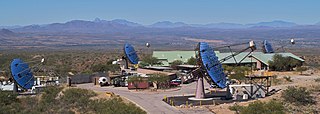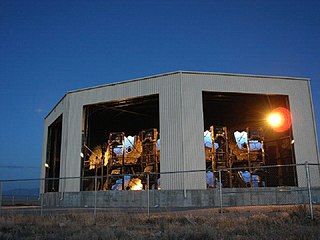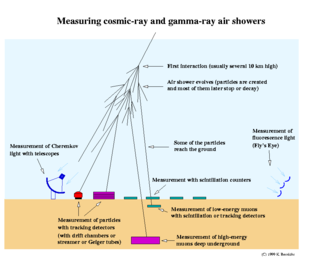
Cosmic rays or astroparticles are high-energy particles or clusters of particles that move through space at nearly the speed of light. They originate from the Sun, from outside of the Solar System in our own galaxy, and from distant galaxies. Upon impact with Earth's atmosphere, cosmic rays produce showers of secondary particles, some of which reach the surface, although the bulk are deflected off into space by the magnetosphere or the heliosphere.
The Greisen–Zatsepin–Kuzmin limit (GZK limit or GZK cutoff) is a theoretical upper limit on the energy of cosmic ray protons traveling from other galaxies through the intergalactic medium to our galaxy. The limit is 5×1019 eV (50 EeV), or about 8 joules (the energy of a proton travelling at ≈ 99.99999999999999999998% the speed of light). The limit is set by the slowing effect of interactions of the protons with the microwave background radiation over long distances (≈ 160 million light-years). The limit is at the same order of magnitude as the upper limit for energy at which cosmic rays have experimentally been detected, although indeed some detections appear to have exceeded the limit, as noted below. For example, one extreme-energy cosmic ray, the Oh-My-God Particle, which has been found to possess a record-breaking 3.12×1020 eV (50 joules) of energy (about the same as the kinetic energy of a 95 km/h baseball).
In astroparticle physics, an ultra-high-energy cosmic ray (UHECR) is a cosmic ray with an energy greater than 1 EeV (1018 electronvolts, approximately 0.16 joules), far beyond both the rest mass and energies typical of other cosmic ray particles.

Air showers are extensive cascades of subatomic particles and ionized nuclei, produced in the atmosphere when a primary cosmic ray enters the atmosphere. When a particle of the cosmic radiation, which could be a proton, a nucleus, an electron, a photon, or (rarely) a positron, interacts with the nucleus of a molecule in the atmosphere, it produces a vast number of secondary particles, which make up the shower. In the first interactions of the cascade especially hadrons are produced and decay rapidly in the air, producing other particles and electromagnetic radiation, which are part of the shower components. Depending on the energy of the cosmic ray, the detectable size of the shower can reach several kilometers in diameter.
The Chicago Air Shower Array (CASA) was a significant ultra high high-energy astrophysics experiment operating in the 1990s. It consisted of a very large array of scintillation detectors located at Dugway Proving Grounds in Utah, USA, approximately 80 kilometers southwest of Salt Lake City. The full CASA detector, consisting of 1089 detectors began operating in 1992 in conjunction with a second instrument, the Michigan Muon Array (MIA), under the name CASA-MIA. MIA was made of 2500 square meters of buried muon detectors. At the time of its operation, CASA-MIA was the most sensitive experiment built to date in the study of gamma ray and cosmic ray interactions at energies above 100 TeV (1014 electronvolts). Research topics on data from this experiment covered a wide variety of physics issues, including the search for gamma rays from Galactic sources (especially the Crab Nebula and the X-ray binaries Cygnus X-3 and Hercules X-1) and extragalactic sources (active Galactic nuclei and gamma-ray bursts), the study of diffuse gamma-ray emission (an isotropic component or from the Galactic plane), and measurements of the cosmic ray composition in the region from 100 to 100,000 TeV. For the topic of composition, CASA-MIA worked in conjunction with several other experiments at the same site: the Broad Laterial Non-imaging Cherenkov Array (BLANCA), the Dual Imaging Cherenkov Experiment (DICE) and the Fly's Eye HiRes prototype experiment. CASA-MIA operated continuously between 1992 and 1999. In summer 1999, it was decommissioned.
The Extreme Universe Space Observatory onboard Japanese Experiment Module (JEM-EUSO) is the first space mission concept devoted to the investigation of cosmic rays and neutrinos of extreme energy (E > 5×1019 eV). Using the Earth's atmosphere as a giant detector, the detection is performed by looking at the streak of fluorescence produced when such a particle interacts with the Earth's atmosphere.
The High Resolution Fly's Eye or HiRes detector was an ultra-high-energy cosmic ray observatory that operated in the West Desert of Utah from May 1997 until April 2006. HiRes used the "atmospheric fluorescence" technique that was pioneered by the Utah group first in tests at the Volcano Ranch experiment and then with the original Fly's Eye experiment. The experiment first ran as the HiRes prototype in a tower configuration operating in conjunction with the CASA and MIA. The prototype was later reconfigured to view 360 degrees in azimuth. HiRes-II followed later and was located on a hilltop about 13km away. HiRes-I and HiRes-II operated in stereo.

The Pierre Auger Observatory is an international cosmic ray observatory in Argentina designed to detect ultra-high-energy cosmic rays: sub-atomic particles traveling nearly at the speed of light and each with energies beyond 1018 eV. In Earth's atmosphere such particles interact with air nuclei and produce various other particles. These effect particles (called an "air shower") can be detected and measured. But since these high energy particles have an estimated arrival rate of just 1 per km2 per century, the Auger Observatory has created a detection area of 3,000 km2 (1,200 sq mi)—the size of Rhode Island, or Luxembourg—in order to record a large number of these events. It is located in the western Mendoza Province, Argentina, near the Andes.
The Akeno Giant Air Shower Array (AGASA) was an array of particle detectors designed to study the origin of ultra-high-energy cosmic rays. It was deployed from 1987 to 1991 and decommissioned in 2004. It consisted of 111 scintillation detectors and 27 muon detectors spread over an area of 100 km2. It was operated by the Institute for Cosmic Ray Research, University of Tokyo at the Akeno Observatory.

The IceCube Neutrino Observatory is a neutrino observatory constructed at the Amundsen–Scott South Pole Station in Antarctica. The project is a recognized CERN experiment (RE10). Its thousands of sensors are located under the Antarctic ice, distributed over a cubic kilometre.

VERITAS is a major ground-based gamma-ray observatory with an array of four 12 meter optical reflectors for gamma-ray astronomy in the GeV – TeV photon energy range. VERITAS uses the Imaging Atmospheric Cherenkov Telescope technique to observe gamma rays that cause particle showers in Earth's atmosphere that are known as extensive air showers. The VERITAS array is located at the Fred Lawrence Whipple Observatory, in southern Arizona, United States. The VERITAS reflector design is similar to the earlier Whipple 10-meter gamma-ray telescope, located at the same site, but is larger in size and has a longer focal length for better control of optical aberrations. VERITAS consists of an array of imaging telescopes deployed to view atmospheric Cherenkov showers from multiple locations to give the highest sensitivity in the 100 GeV – 10 TeV band. This very high energy observatory, completed in 2007, effectively complements the Large Area Telescope (LAT) of the Fermi Gamma-ray Space Telescope due to its larger collection area as well as coverage in a higher energy band.
Astroparticle physics, also called particle astrophysics, is a branch of particle physics that studies elementary particles of astronomical origin and their relation to astrophysics and cosmology. It is a relatively new field of research emerging at the intersection of particle physics, astronomy, astrophysics, detector physics, relativity, solid state physics, and cosmology. Partly motivated by the discovery of neutrino oscillation, the field has undergone rapid development, both theoretically and experimentally, since the early 2000s.
Milagro was a ground-based water Cherenkov radiation telescope situated in the Jemez Mountains near Los Alamos, New Mexico at the Fenton Hill Observatory site. It was primarily designed to detect gamma rays but also detected large numbers of cosmic rays. It operated in the TeV region of the spectrum at an altitude of 2530 m. Like conventional telescopes, Milagro was sensitive to light but the similarities ended there. Whereas "normal" astronomical telescopes view the universe in visible light, Milagro saw the universe at very high energies. The light that Milagro saw was about 1 trillion times more energetic than visible light. While these particles of light, known as photons, are the same as the photons that make up visible light, they behave quite differently due to their high energies.

The Telescope Array project is an international collaboration involving research and educational institutions in Japan, The United States, Russia, South Korea, and Belgium. The experiment is designed to observe air showers induced by ultra-high-energy cosmic ray using a combination of ground array and air-fluorescence techniques. It is located in the high desert in Millard County, Utah, United States, at about 1,400 meters (4,600 ft) above sea level.

A cosmic-ray observatory is a scientific installation built to detect high-energy-particles coming from space called cosmic rays. This typically includes photons, electrons, protons, and some heavier nuclei, as well as antimatter particles. About 90% of cosmic rays are protons, 9% are alpha particles, and the remaining ~1% are other particles.
The Washington Area Large-scale Time-coincidence Array (WALTA) is a cosmic ray physics experiment run by the University of Washington to investigate ultra high energy cosmic rays (>1019eV). The program uses detectors placed at Seattle-area high schools and colleges which are linked via the internet, effectively forming an Extensive Air Shower array. In addition to working on the unexplained levels of Ultra High Energy cosmic ray (UHECR) flux, it hopes to serve as a pedagogical tool for increasing the physics involvement of high schools and community colleges with a University level physics experiment. Each site has three to four scintillation detectors with the goal of having enough sites to cover a 200 km2 area around the city of Seattle. WALTA is a part of the larger NALTA project which hopes to combine data from several WALTA like projects to further the exploration of UHE cosmic rays.

Gamma-ray astronomy is the astronomical observation of gamma rays, the most energetic form of electromagnetic radiation, with photon energies above 100 keV. Radiation below 100 keV is classified as X-rays and is the subject of X-ray astronomy.

John David Linsley (12 March 1925 – 15 September 2002) was an American physicist who performed pioneering research on cosmic rays, particularly ultra-high-energy cosmic rays. He did his most significant work from 1959 to 1978 using a ground-based array of detectors at Volcano Ranch in New Mexico. He is best known for being the first to detect an air shower created by a primary particle with an energy of 1020 eV. This was the highest energy cosmic ray observed up to that point. Linsley's observations suggested that not all cosmic rays are confined within the galaxy and showed the first evidence of a flattening of the cosmic ray spectrum at energies above 1018 eV.
Eugene Chen Loh was a Chinese American physicist, having been Distinguished Professor Emeritus at University of Utah and was a Fellow of the American Physical Society.
The Giant Radio Array for Neutrino Detection (GRAND) is a proposed large-scale detector designed to collect ultra-high energy cosmic particles as cosmic rays, neutrinos and photons with energies exceeding 1017 eV. This project aims at solving the mystery of their origin and the early stages of the universe itself. The proposal, formulated by an international group of researchers, calls for an array of 200,000 receivers to be placed on mountain ranges around the world.












